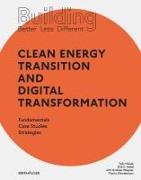- Start
- Building Better - Less - Different: Clean Energy Transition and Digital Transformation
Building Better - Less - Different: Clean Energy Transition and Digital Transformation
Angebote / Angebote:
Sustainability Sustainability is to become the guiding principle of social action and economic activity. At the same time, its ways and means are far from clear. As a holistic praxis, sustainability must combine technical and material as well as social, economic, ecological and also ethical strategies, which have multiple complex interactions and all too often also conflicting goals and priorities. In no other field can these be better observed, addressed and influenced than in architecture and building. "Building Better - Less - Different" Each volume of "Building Better - Less - Different" details two fundamental areas of sustainability and explores their specific dynamics and interactions. After introductory overviews, innovative methods and current developments are described and analysed in in-depth essays, international case studies and pointed commentaries. The sustainability criteria of efficiency ("better"), sufficiency ("less") and consistency ("different") form the framework for each book. What the press say about the first volume
"Circular Construction and Circular Economy" "The articles, case studies and commentaries in this book make a major contribution to advancing the current discourse on implementing circular-based economic models in the building sector." Hessian Chamber of Architects, book reviews "To think of tomorrow when building today is the core message that Dirk E. Hebel and Felix Heisel want to convey to their readers. ... And they also show us how: with the help of relevant examples, grouped under the headings 'better', 'less' and 'different', they demonstrate concrete applications and argue that circular construction can also benefit the construction industry..." architektur aktuell Clean energy transition It has long been common knowledge that energy and sustainability are closely interlinked. And yet we are witnessing a profound shift in the sector. While the earlier focus was on improving energy efficiency and increasing the proportion of renewable energy in buildings, current energy conservation policies are supporting a broader, more holistic view. This encompasses integral approaches in which building design and construction measures form part of the energy concept from the outset, as well as accounting for grey energy in building materials and a holistic evaluation of buildings over their entire life cycle. For the energy-intensive and emission-producing building sector, climate change presents an even greater challenge than conserving resources. How can we contribute to a shift in heating strategies and employ new technologies to achieve climate-neutral heating? How can we respond to rising temperatures and the risk of increased energy consumption for cooling? Can low-tech concepts help to reduce the environmental impact of buildings over their life cycle? Shouldn't we take greater account of the users of buildings, and do we need completely different energy supply strategies? Digital Transformation At a time of natural ubiquity of digital tools, widely adopted to streamline project delivery in architecture, the foundations have been laid for a profound transformation of the construction industry to address the climate crisis. Digital architectural design and construction methods can be used as enabling technologies for a fundamental change towards a circular construction approach with significantly reduced ecological and climate impact. This approach comprises a digital reinterpretation of natural building materials through digital construction technologies. Digital deconstruction and reuse strategies can transform the existing building stock into resources for the future. Mass customization of tailor-made building components minimizes resource consumption. Architects, in their emerging role as interdisciplinary interface and digital master builders, reunite design and making through digital craft. Finally, the book provides a glimpse into the potential future of construction, which might be characterized by fundamentally different concepts of design and materialization of our built environment, challenging current paradigms within our discipline.
Libri-Titel folgt in ca. 2 Arbeitstagen
